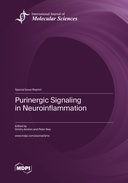Explore

Purinergic Signaling in Neuroinflammation
0 Ungluers have
Faved this Work
Login to Fave
It is currently apparent that extracellular ATP's physiological effect is mediated by its interaction with specific purinergic receptors. All purinergic receptors are divided into P1-purinoreceptors and P2-purinoreceptors. Each of the subtypes is divided into a number of families. For instance, P2 receptors are divided into P2X and P2Y receptors according to the mechanism by which their effect is realized: P2Y are G-protein-coupled receptors, while P2X receptors are ligand-operated ion channels. P2X receptors are important molecular therapeutic targets, the malfunctioning of which leads to severe complications in the physiology of humans and animals and causes dangerous diseases. The search for compounds that can modulate the function of purinergic receptors can lead to the creation of new drugs that are effective in central and peripheral nervous system and immune system disease treatment, including neuroinflammation, hypoxia/ischemia, epilepsy and neuropathic pain. In this Special Issue, we wish to offer a platform for high-quality publications on the latest advances in the identification of P2X/Y- and P1-receptor blockers, functions and regulation by them; the characterization of these receptor signaling networks and crosstalk; mechanisms underlying the role of purinoceptors in neurodegenerative illnesses as well as chronic neuronal changes following acute noxious damage and therapeutic opportunities associated with regulation of purinergic receptor activity.
This book is included in DOAB.
Why read this book? Have your say.
You must be logged in to comment.
Rights Information
Are you the author or publisher of this work? If so, you can claim it as yours by registering as an Unglue.it rights holder.Downloads
This work has been downloaded 96 times via unglue.it ebook links.
- 96 - pdf (CC BY) at Unglue.it.
Keywords
- A2B receptors
- Adenosine
- adenosine receptors
- Adipogenesis
- Adipose Tissue
- antinociception
- astroglia
- ATP
- autoimmune disease
- Biology, Life Sciences
- Bone Marrow
- canine
- CD39
- CD73
- cerebral ischemia
- Demyelination
- Depression
- Development
- DH82
- dog
- dorsal root ganglion
- ectonucleotidases
- endometriosis
- endometrium
- ex vivo organotypic brain slice co-culture
- G protein-coupled receptor 17 (GPR17)
- gallic acid
- glycine transporters
- glycinergic neurotransmission
- guanosine
- Hippocampus
- inflammasome activation
- Inflammation
- Inflammatory diseases
- macrophage
- Macrophages
- Mathematics & science
- Microglia
- montelukast
- n/a
- neonatal seizures
- neurite outgrowth
- neurodegeneration
- neurodegeneration and neuroregeneration
- neuroinflammation
- Neuroprotection
- NG2
- Obesity
- oligodendrocyte differentiation
- osteogenesis
- oxygen-glucose deprivation
- P2X
- P2X4 receptor
- P2X7 receptor
- P2X7R
- P2Y
- P2Y2 receptor
- Pain
- pore formation
- purinergic modulation
- purinergic receptors
- purinergic signaling
- purinergic signalling
- Reference, information & interdisciplinary subjects
- Research & information: general
- Retina
- Spinal cord
- Stroke
- thema EDItEUR::G Reference, Information and Interdisciplinary subjects::GP Research and information: general
- thema EDItEUR::P Mathematics and Science::PS Biology, life sciences
- Visceral Pain
Links
DOI: 10.3390/books978-3-0365-7686-2Editions

